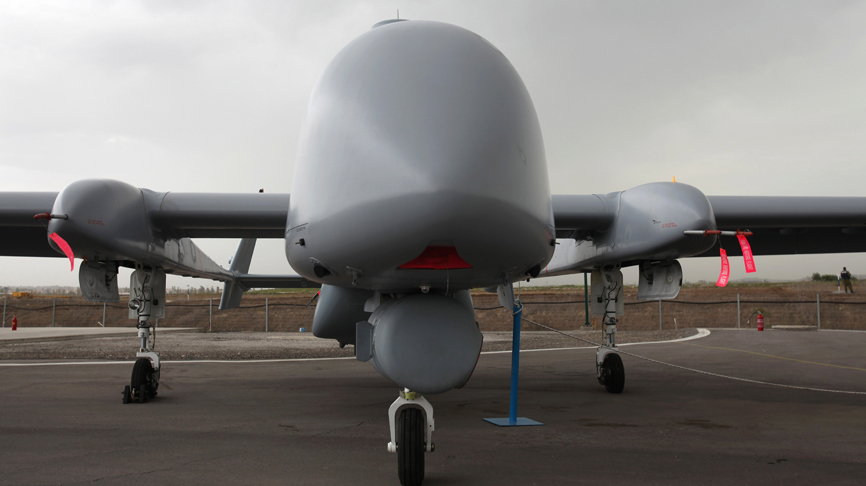Germany’s new government has endorsed the arming of uninhabited aerial vehicles in its coalition agreement. The decision should only be seen as a first step in the acquisition of additional UAV strike capabilities, argue Franz-Stefan Gady and Oskar Glaese.
While security on NATO’s eastern flank has markedly deteriorated over the past decade, and the German armed forces have in response renewed their focus on Bündnisverteidigung or collective defence, there has been at least one constant in recent years: Berlin’s inability to decide whether to field armed uninhabited aerial vehicles (UAVs). This has now changed. Germany’s new government – a coalition of the Social Democratic Party (SPD), the Liberal Party (FDP) and the Green Party – has endorsed the arming of UAVs in its new coalition agreement, albeit on the condition that they are used solely for the purpose of protecting German soldiers.
The SPD, the party that took the largest percentage of the national vote in the September 2021 elections, remains divided on the issue of armed UAVs. In 2020, the SPD’s then-parliamentary spokesperson for defence policy resigned in protest following the party’s Bundestag vote against acquiring armed UAVs. The FDP has in the past endorsed the procurement of armed UAVs, while during the recent election campaign the SPD and the Green Party argued that there was a need for yet further debate. A working group convened by the SPD concluded that arming UAVs could again be considered. Early indications from the coalition talks, which seemed to suggest that the new government was leaning towards approving the acquisition of armed UAVs for the Bundeswehr, have turned out to be correct. The issue represents a tenuous political compromise, however.
Limited operational utility
While not mentioned in the coalition agreement, the German Bundeswehr aims to lease up to five Israeli-made Heron TP medium-altitude, long-endurance (MALE) UAVs, which it will arm with air-to-ground precision munitions. The Heron TP’s primary role will be to provide intelligence, surveillance and reconnaissance (ISR). Although this is an important signal by the new German government to its allies and partners, the operational significance of the armed Heron TP should not be overstated and there remain various unresolved issues pertaining to the operation of other uninhabited aerial platforms in the Bundeswehr.Despite a renewed focus on NATO’s eastern flank, the Heron TP will in fact have limited operational utility in any high-intensity conflict against a peer-adversary such as Russia, and will likely be confined to low-intensity operations. Following training in Israel, the Bundeswehr plans to deploy the Heron TP, attached to the Luftwaffe’s Tactical Air Wing 51, to Mali by 2024. While the exact armament of the Heron TP remains classified, the air-to-surface precision-attack munition will be Israeli-made, and its warhead fitted with an adjustable yield to reduce the chances of civilian casualties in military operations. In addition to the Heron TP, the Bundeswehr also operates a range of ISR UAVs, among them another three Heron 1 MALE UAVs, also leased from Israel. These have been deployed in Afghanistan and Mali, and are also not operationally suitable for a high-intensity conflict.
Meanwhile, issues surrounding the Bundeswehr’s acquisition of larger UAVs remain unresolved. The Heron TPs are seen as a stop-gap to provide additional ISR capabilities before transitioning to the Eurodrone, which is the latest attempt by European countries to develop a long-endurance UAV. While France is expected to consider acquiring a weapons-capable version of Eurodrone, given that it already operates armed MQ-9 Reaper UAVs, there is no indication as to whether Berlin will follow suit.
A further issue for Germany is the approach it takes to part of the trinational Future Combat Air System (FCAS), in which it is a partner alongside France and Spain. The crewed combat aircraft element of the programme is complemented by what are termed ‘remote carriers’, which will have characteristics similar to those of an uninhabited combat air vehicle. Given that the FCAS will not enter service until around 2040, Berlin still has time to make a decision as to whether or not these platforms will be armed.
Future applications
While the current generation of ISR and armed UAVs has been designed for and operated in permissive air environments, armed UAVs will have clear applicability in dealing with the future challenges of contested air space and in providing combat mass to bolster crewed platforms. Presently these options are not available to the German armed forces, for example in using armed UAVs in the suppression or destruction of enemy air defences. Human-machine teaming or the integration of manned and unmanned air platforms has been a particular focus of novel operational concepts among leading NATO powers. Under such concepts, armed UAVs act as precision-strike platforms to degrade integrated air-defence systems. Relying solely on the use of crewed aircraft for such a role inherently carries the risk of personnel losses.Germany’s long-standing impasse over the introduction of armed UAVs has meant that roles that could have been handed off to remotely operated uninhabited systems had until now been met by crewed platforms. It has also meant that the armed forces have built up no experience in armed UAV operation to help inform decision-making and planning. From the Bundeswehr’s perspective, this can hardly be edifying. Indeed, the arming of five Heron TPs should only be seen as a first step in the acquisition of additional UAV strike capabilities, and the German government would do well to lay the groundwork for the introduction of additional armed UAV platforms capable of operating in non-permissive environments in the coming decade.

Germany to operate armed UAVs: too little too late?
Germany’s new government has endorsed the arming of uninhabited aerial vehicles in its coalition agreement. The decision should only be seen as a first step in the acquisition of additional UAV strike capabilities, argue Franz-Stefan Gady and Oskar Glaese.

